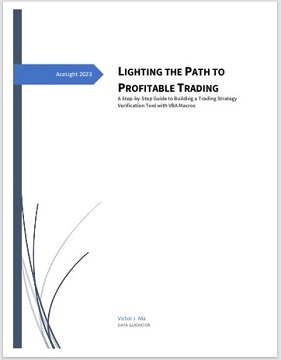Cracking the Code: A Guide to Stock Trading Strategies Backtest
|
|
Have you ever wondered why stock traders are always glued to their screens,
staring at charts and squiggly lines all day long? It's not just because
they find it mesmerizing - well, not entirely. The truth is that they're on
a never-ending quest to find that holy grail of trading: the perfect
strategy. And what better way to do that than by endlessly backtesting every
conceivable combination of indicators, parameters, and trading rules? It's
like trying to crack the Da Vinci Code, only with more caffeine and fewer
cryptic symbols. So, grab your favorite energy drink, and let's dive into
the wonderful world of stock trading strategies backtesting.
As a
trader, one of the most crucial aspects of successful stock trading is the
development of a robust trading strategy. A trading strategy is a set of
rules that guide a trader's decision-making process when it comes to buying
and selling stocks. However, before implementing a trading strategy in the
live market, it's crucial to backtest it. Backtesting allows traders to
evaluate the effectiveness of their trading strategies in historical market
conditions. In this blog post, I will discuss three stock trading strategies
and how they can be backtested.
1. Moving Average Crossover Strategy:
The moving average crossover strategy is a trend-following strategy that
aims to capture the market's momentum. The short-term moving average is
typically set to a lower period (e.g., 20 days), while the long-term moving
average is set to a higher period (e.g., 50 days).
Traders can use
different variations of the moving average crossover strategy, such as using
three or more moving averages of varying lengths or incorporating other
indicators like the MACD. Additionally, traders can use different timeframes
for the moving averages, depending on their trading style and the volatility
of the stock they're trading.
When backtesting the moving average
crossover strategy, traders should pay attention to the number of trades
generated and the trade's duration. A strategy that generates too many
trades or has a short trade duration may result in higher trading costs and
lower profitability.
2. Bollinger Bands Strategy:
The
Bollinger Bands strategy is a mean-reversion strategy that aims to identify
overbought and oversold conditions. The Bollinger Bands are plotted two
standard deviations away from the moving average, representing the upper and
lower bounds of the price range.
Traders can adjust the Bollinger
Bands' parameters, such as the number of standard deviations or the length
of the moving average, to suit different market conditions. For instance, a
shorter period moving average and tighter bands may work better for volatile
stocks, while a longer period moving average and wider bands may work better
for less volatile stocks.
When backtesting the Bollinger Bands
strategy, traders should analyze the frequency and magnitude of price
movements outside the bands. A strategy that generates too many false
signals or fails to capture significant price movements may not be effective
in the live market.
3. Relative Strength Index (RSI) Strategy:
The RSI strategy is a momentum-based strategy that aims to identify
overbought and oversold conditions. The RSI indicator ranges from 0 to 100,
with values above 70 indicating overbought conditions and values below 30
indicating oversold conditions.
Traders can adjust the RSI's
parameters, such as the overbought and oversold thresholds or the length of
the smoothing period, to suit different market conditions. For instance, a
shorter smoothing period may generate more signals but may also be more
sensitive to market noise.
When backtesting the RSI strategy, traders
should analyze the frequency and duration of signals generated by the
indicator. A strategy that generates too many signals or fails to capture
significant price movements may not be effective in the live market.
In all cases, traders should keep in mind that backtesting is not a
guarantee of future performance. Market conditions may change, and past
performance does not guarantee future results. Therefore, traders should use
backtesting as a tool to evaluate the effectiveness of their trading
strategies and adjust them accordingly.
Let's review how some good
traders comment on trading strategies backtest:
1. "Backtesting is a
key component of effective trading-system development. It is accomplished by
reconstructing, with historical data, trades that would have occurred in the
past using rules defined by a given strategy." - Keith Fitschen
2.
"Backtesting is crucial to the success of any trading system. It allows you
to quantify the performance of your system and gives you the confidence to
stick with it during drawdowns." - Ed Seykota
3. "Backtesting is
essential to gauge the effectiveness of a trading strategy. If you don't
test, you are just gambling." - Victor Sperandeo
These quotes
highlight the importance of backtesting in developing and evaluating trading
strategies. By backtesting, traders can gain insights into their strategy's
effectiveness and identify any weaknesses before risking real capital in the
live market.
Here are some general steps to follow when conducting a
stock trading strategies backtest:
1. Define your trading strategy:
Start by defining your trading strategy, including the entry and exit rules,
the indicators you plan to use, and any other relevant parameters.
2.
Select historical data: Collect historical data for the security or
securities you plan to trade. Ensure that the data is clean and accurately
reflects the market conditions during the time period you plan to test.
 3.
Set up your backtesting system and pick the right tools: There are several
backtesting platforms available; however, if you want to take control of all
the steps and understand what is happening in every stage of the backtest,
we recommend you set up your own backtesting system and build your own
backtest tools. This will help you be more confident. Don't be scared by
those complicated codes; there are some simple tools that can help. More
details:
Click
LIGHTING THE PATH TO PROFITABLE TRADING: A Step-by-Step Guide to Building a Trading Strategy Verification Tool with VBA Macros to get the whole tutorial handbook for free! 3.
Set up your backtesting system and pick the right tools: There are several
backtesting platforms available; however, if you want to take control of all
the steps and understand what is happening in every stage of the backtest,
we recommend you set up your own backtesting system and build your own
backtest tools. This will help you be more confident. Don't be scared by
those complicated codes; there are some simple tools that can help. More
details:
Click
LIGHTING THE PATH TO PROFITABLE TRADING: A Step-by-Step Guide to Building a Trading Strategy Verification Tool with VBA Macros to get the whole tutorial handbook for free!
4. Run the backtest: Once you have set up the system, run the backtest
and analyze the results. Pay attention to the number of trades generated,
the average profit and loss per trade, the maximum drawdown, and any other
relevant performance metrics.
5. Analyze the results: Analyze the
results of your backtest to identify any weaknesses in your strategy or
opportunities for improvement. For instance, you may find that your strategy
generates too many false signals or that it performs poorly during certain
market conditions.
6. Optimize your strategy: Use the insights gained
from the backtest to optimize your trading strategy. This may involve
adjusting the entry and exit rules, changing the parameters of your
indicators, or incorporating additional indicators or filters.
7.
Repeat the backtest: Once you have made changes to your trading strategy,
repeat the backtest to evaluate its performance. Continue to refine your
strategy and repeat the backtesting process until you are satisfied with its
performance.
It's worth noting that backtesting is not a guarantee of
future performance, and there are limitations to what can be achieved with
historical data. However, by following these steps and using backtesting as
a tool for refining and evaluating your trading strategies, you can improve
your chances of success in the live market.
In conclusion, stock
trading strategies backtesting is a crucial tool for traders to refine their
strategies and gain insights into their performance. However, it's important
to remember that backtesting is not a magic bullet, and even the most
meticulously crafted strategy can fall victim to the unpredictable nature of
the markets. So, the next time you find yourself knee-deep in backtesting
results, remember to take a break and enjoy the simple things in life - like
a good cup of coffee, a warm hug from a loved one, or a hilarious meme about
stock trading. After all, laughter is the best medicine, and you never know
when you'll need a dose to get through those inevitable trading slumps.
Happy trading, and may the backtesting gods smile upon you!
Click Free Trial to download strategies testing tools, all for a 30-day Free Trial.
Click on Subscription to order more strategies testing tools to help your stock trading.
|


|

Free Tutorial
Share
|
|
|
|